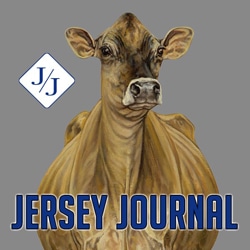Poulin Believes in Technology and the Jersey Cow
When visiting Poulin Farms in Newport, Vt., the breathtaking views surrounding the dairy will stop anyone in their tracks. On one side, you see a seemingly endless wilderness of trees, hills and other natural beauty. The other direction boasts the Registered Jersey farm with a picturesque view of Lake Memphremagog and Canada behind it.
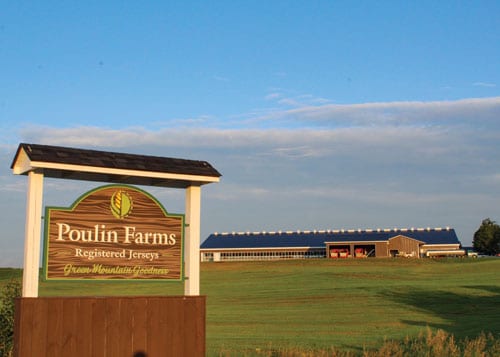
Josh Poulin is passionate about the dairy industry. So much so, that after running a grain and feed mill business for years, Poulin Grain, he decided to add dairy farming to his resume. A born and bred businessman, Josh immediately saw the advantages of the Registered Jersey cow.
After meeting Josh, it should come as no surprise the level of care and attention to detail that is executed at both businesses. Extensive focus is placed on the pedigrees of his animals, which were sourced from some of the best herds in the country. He also surrounds himself with a strong workforce.
It is quite logical that to pair with the amazing views, Poulin Farms is an immaculate operation. Josh and his employees ensure the animals receive top-notch care and live in the best, most comfortable environment possible.
This breeder feature will talk about the management of the herd milked by six Lely A4 robots, how Jerseys was and is the right decision and the relationship between Poulin and the American Jersey Cattle Association.
History
Growing up, Josh Poulin was involved in many aspects of agriculture. Coming from a long line of business savvy individuals, his great-grandfather, A.J. Poulin, came to Newport Center from Canada in the early 1900s. His son and Josh’s grandfather, Gaston Poulin, settled on the farmstead used today in the early 1980s. It can be seen below.
Gaston expanded on the business opportunities for the family. In addition to his milking herd of Holstein cattle, he had the opportunity to enter the feed sales industry and start his own grain marketing and feed mill business, known today as Poulin Grain. He and his two sons also started a lumber business.
Years later, Josh’s father, Jeff, decided that his destiny was to be involved with the grain business. Josh’s uncle continued milking 120 Holsteins and running the lumber business, until about 10 years ago when he sold the dairy herd. Eventually Josh worked with his father to take over the family grain business in 2008. Since that time, Poulin Grain has continued to grow under Josh’s leadership.
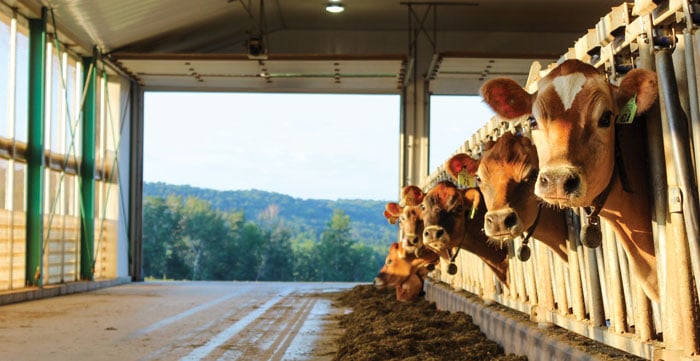
Josh has always held a special place in his heart for animal agriculture. After his uncle sold the dairy cattle, Josh began running his herd of registered Piedmontese beef cattle at the farm. A herd known across the country for its elite genetics, Josh decided to exit the beef business given his geographic location which provided additional challenges.
However, Josh had other plans. “I have always liked to see family farming businesses, especially dairy farming, survive,” commented Poulin. Therefore, he began looking into starting a dairy farm of his own.
Journey to Dairy Farming
Josh knew that he was going to dairy farm with Registered Jersey cattle. When asked why, he replied, “Jerseys are what make sense. They have sound feet and legs, a desirable size, eat less, and more efficiently convert energy into solids.”
A progressive thinker, Josh believes that other breeds need to start altering their mindsets. As the industry continues to push towards a preference of higher solids, he knew milking Jerseys was a step in the right direction as he began planning for the construction of his new operation.
With the impending completion of the freestall barn with four robotic milking systems, Josh began searching for quality animals to start his herd at Poulin Farms. A man who appreciates quality animals with solid pedigrees, Josh knew he needed help to obtain the best animals for his needs. Thus began the working relationship between him and the AJCA and National All-Jersey Inc. (NAJ).
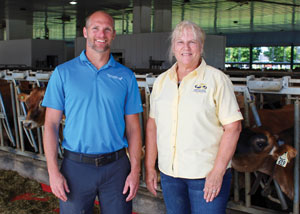
With the aid of Jersey Marketing Service (JMS), Josh was able to purchase animals that met his needs. He had a strict criterion though. The animals needed to have Very Good dams and grandams, as well as excellent udder traits and be plus for Parent Average milk production. Through private treaty sales, Josh obtained a load of animals from the Midwest, as well as loads from the Northeast. He also purchased groups of animals at both the Mid-Atlantic Fall Jersey Classic Sale and the Northeast Jersey Classic and Breeders Sale, both managed by JMS.
Josh has always had an appreciation for genetics and believes it is important to have the parentage information and history behind each individual animal. This led to his decision to also enroll in the REAP (Registration, Equity, Appraisal and Performance) program through the AJCA.
Throughout this process, AJCA-NAJ Area Representative Brenda Snow has worked with Josh to make sure he was pleased with his new purchases and the services that the AJCA provides him and other Jersey farmers. “It makes financial sense to enroll in REAP,” said Snow. “Having the records and information behind the animals is so important. By being a part in the program, Josh will get his investment in the program back with the increased genetic knowledge and data collection that he can use to make decisions.”
Today’s Operation
Currently the farm hires three full-time and two part-time individuals in addition to Josh. These individuals allow Josh the flexibility to split his time between the grain business, farm and young family. The farm owns approximately 680 acres of land, upon which 400 are grass and 280 corn. Josh also rents an additional 100 acres. Josh is also not afraid to try new things, especially when it comes to technology.
Today the operation features some of the industry’s newest technology and Josh was happy to explain exactly how these systems work and have helped him be successful over time.
Lactating Herd
Within recent years, Poulin Farms has seen its fair share of rebuilding and construction projects. In 2019, two additional robots were added to the milking barn to allow for two more groups of cows, making a total of six milking systems in the herd.
Today, there are four pens of cows in the milking cow herd. Two are larger groups with about 120 cows each with two robots per pen. The other pens are smaller groups, including one for the recently fresh animals. Since adding the recently fresh pen, Poulin has seen positive results in the performance and recovery of the animals. Overall, the herd averages 3.2 milkings each day per animal with a resulting 65 lbs. milk, 5.09% fat and 3.71% protein average daily production.
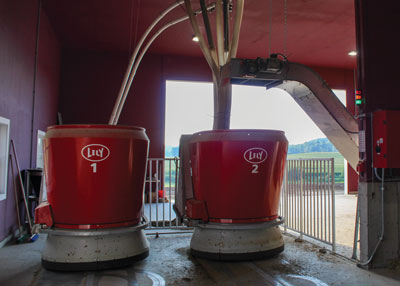
Just two weeks prior to our August 2020 visit, Josh installed the Lely Vector Automated Feeding System. Since starting to use the system, the milking herd increased 5 lbs. of milk in just 14 days. Throughout the day, one of the machines goes to measure the amount of feed at the mangers. If there is less than five inches of matter available to eat, the machine communicates to its partner to start mixing a fresh batch of feed. This system ensures fresh feed is always available for the cows to eat. Each day, the lead feedsperson for the farm fills the two large hoppers with haylage and corn silage in the morning. Prior to leaving, he tops off the bins to ensure the cows will have enough feed until the next day. There are also commodity boxes filled with the other ration ingredients, as well as the supplements the cows receive when they go through the milking robot. The robots also mixes the prefresh and heifer feed. While this feed isn’t distributed by the robots, an employee takes it to the appropriate pen and ensures it is distributed as needed.
The herd is fitted with an activity tracking system that also assists in heat detection. Each day, the herdsperson looks at the computer system which tells how much the cows are producing, fat-to-protein ratios, milking speed, rumination and overall activity. This helps to determine which animals may need to be brought to the robot for milking, who needs special attention to determine illness or ailment and which cows need to be put on the breeding list for the day.
After calving, cows are on a 60-day voluntary waiting period, upon which they are serviced at the first heat. If no heats have been shown by 45 days, cows are given a shot of Lutalyse and checked by the veterinarian at 70 days fresh. While it is not often needed, cows are put on an OvSynch program at 100 days in milk if not yet serviced. Heifers are first serviced at 12 months of age. “The heat detection/activity system has worked great for us,” said Josh. “It’s a great technology.”
The manure alleys are cleaned using the Lely Discovery Collector—a robot that vacuums the waste and deposits it at the end of the barn to be taken to a dispensing area where manure is than gravity flowed to the manure pit.
Heifers and Calves
Poulin Farms raises all the heifer calves born on the operation. After birth, the calves are given two feedings of pasteurized colostrum. They are moved to the recently constructed calf barn, built with optimum ventilation and calf comfort in mind. Calves are transitioned to an acidified milk replacer marketed by Poulin Grain after receiving their colostrum.
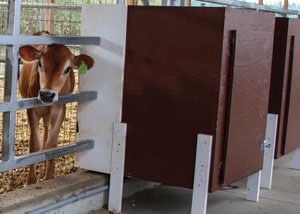
At approximately five to seven days old, the calves are moved into groups of five and put onto a mob feeding system with the acidified milk replacer. Each morning, the calf feeder replaces the barrel with a clean and sanitized one, subsequently filling the feeder to last the calves until the next morning. Fresh grain mix is also provided to the calves as needed. When weaned at about 57 days, the calves are consuming approximately three gallons of milk per day and 2 lbs. of grain each.
From the calf barn, calves are moved to heifer veranda set-ups for another two months. Here they receive a total mixed ration (TMR) and heifer grain. While in this area, calves also receive their vaccination protocols which consist of BoviShield and Calvary 9. Once they grow out of this area, the calves are moved to a three-sided heifer barn until they are approximately breeding age.
One of the most exciting projects currently taking place at Poulin Farms is the construction of a new barn which will allow for breeding age heifers to be raised on the farm. Previously this group of heifers were at an offsite location. Once heifers are confirmed pregnant, they are put onto pasture until they are close to calving. Also included in the new barn are dry cows and close-up individuals. A calving pen was also constructed with cow comfort and labor in mind.
Poulin Farms Philosophies
With having purchased animals from throughout the United States, it has taken time and patience to reach the level of performance that the herd is at now. The amount of data for each of the animals was extensive and needed to be input into two programs – Lely’s Time for Cows (T4C) program and PCDart.
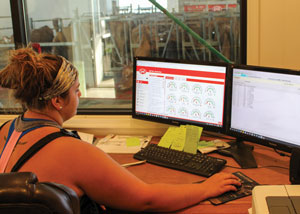
Josh knows what he wants when it comes to performance and type. He is breeding his animals to produce higher pounds of solids, while maintaining a respectable daughter pregnancy rate (DPR). In addition, he has to keep robot function in mind, so cows need to have level udder floors and good teat placement. A nod to the breed, he appreciates the functional vigor it produces and looks to maintain good feet and legs on all his animals.
Bulls being used in the herd recently have been “Whistler,” “Disco,” “JX Octavius {6},” “JX Jaywalk {6},” “Demos-P,” “Change-Up,” “Craze” and “Oliver-P.” “I prefer to breed my animals to full Jersey bulls,” noted Josh. “I think it is important to maintain cow size, as well as the other traits the Jersey breed is known for.”
All heifer calves are being genomically tested. The results of the tests combined with overall cow performance allow Josh and his employees to determine which animals are bred to Jersey or beef sires. At this time, the determined genetically lowest 30% of the herd is bred to Limousin, known to be the ideal beef cross for Jersey cattle.
Involvement and the Future
A firm believer in continuous advancement, Josh is always looking at what steps to take next with his businesses – both dairy and grain. With the future of the dairy, Josh has looked into adding a value-added proponent, but isn’t quite sure what route he wants to take.
In April 2019, Josh attended NAJ’s Valued-Added 101 Workshop hosted in Brattleboro, Vt. The three-day event features value-added industry experts who go through business planning and marketing aspects. In addition, attendees listen to presentations or attend farm tours of current value-added businesses and hear firsthand their experiences as processors. In comments about the program, Josh said, “Overall, the entire program was very helpful. It highlighted a lot of different avenues for success and I appreciated that.”
Before he decides his next steps, Josh knows he needs to determine the appropriate market in his area for a successful value-added or other type of business.
Above all, Josh’s true pride is his four children—Mia, 17; Star, 13; Quinne, 10; and Hudson, 8. Although running multiple businesses is no easy task, he makes sure to spend time with his children, making memories both on and off the farm.
